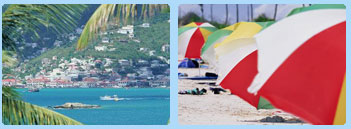|
Barbados

Barbados is a relatively flat island with an abundant supply
of large gradually sloping beaches fringing the land. In
some areas, notably the North, coral and sandstone cliffs
rise straight out of the sea reaching several hundred feet
in height. In the South West, cliffs of 50 to 100 feet rise
and fall along the coast, separated by small sandy beaches
and bays.
On the flatter South West and West coasts, you may walk
for miles along unbroken white sand beaches, sometimes stopping
at a cluster of coral rocks jutting out to sea. All along
the shore large and small beaches are broken by coral formations,
the soft coral rocks weathered by the ocean surf, forming
abstract sculptures to an artist's eye.
Of course, not all of Barbados' coast is sand; there are
mangrove swamps, cliffs, tide pools and areas where beds
of low lying coral rock, sandstone, clay or shale reach
out to the sea. Barbados' swamps are to be found in Chancery
Lane, Inch Marlow and Graham Hall in the South and South
West of the Island. They are the major wetlands of Barbados
providing an assemblage of plants and animals forming an
important link in the food chain of offshore fish and birds.
Low lying rock formations are particularly prevalent along
the North East and South Easter points; periwinkles, sea
anemones, crabs and snails make their home along these rocks.
Tidal flats and wave ridges occur mostly off the East coast
within eroded limestone plateaus and other low lying rock
formations.
On the South and South West Coasts you will find many tide
pools, an important ecological resource, acting as nurseries
for juvenile fish and other permanent residents like the
ghost crab and sea roaches as well as marine plants like
sea moss which is made into a health drink.
Cliffs of coral and sandstone overlook calm bays and rugged
coastlines and sometimes small, cozy soft sand beaches nestle
between heads of coral sculptured by the sea. Most of the
larger cliffs are in the North, in the parish of St. Lucy.
From the air the island is in the shape of a pear. Graced
by gently rolling hills, sugar cane fields and spectacular
beaches - Barbados is one of the most densely populated
islands in the Caribbean and visitors quickly experience
small winding roads that strain with weight of traffic as
cars drive on the left hand side past pastel colored homes,
gardens, historic stone buildings, churches, statues and
parks. As far islands go it is not very big, measuring only
166 square miles. But just about everything on her 166 miles
makes Barbados unique. First of all the island actually
sits just to the east of the Caribbean islands that arch
down toward nearby South America.
Another unique feature is that the island is made up of
limestone with no massive volcano rising from the sea to
challenge the sky. This limestone formation created some
of the best tasting water in the world as well as incredible
beaches that seem to pop up on every nook and cranny on
the coastline.
The island is also unique with her mixture of English traditions
and Caribbean style. Often called "Little England"
the island is home to stone buildings, homes and churches
built centuries ago. If one did not see nearby swaying palm
trees he might be convinced he was in some London neighborhood.
Other similarities to England can be seen in the cricket
fields, polo grounds and elegant restaurants where people
pause for afternoon tea. But these highly educated people
with their unique British-West Indies accent are proud of
their vibrant nation and gladly welcome people to their
shores and quickly make them feel at home.
People, History & Culture: Several mysteries concern
the ancient history of Barbados. It is thought that Arawak
Indians lived on the islands for centuries before the arrival
of European explorers. When the Portuguese arrived at Barbados
in 1536 they reported no inhabitants lived on the island.
It is thought that the Arawaks had moved off the island
or been decimated by the more powerful Carib Indians. Though
the Portuguese did not stay and establish any settlements
on the island they did give the island its modern name-
Los Barbados- named after a shaggy fir tree that can still
be found on the island- meaning the "Bearded Ones".
Today: The people of Barbados are often called by their
nickname- Bajuns. The island has a literacy rate of 98%.
They are proud of their ties to England and enjoy cricket
and afternoon tea. People still wear light jackets for dinner,
observe manners and speak with more of a British accent
than a pure "West-Indies" accent found on other
Caribbean Islands. But while they respect their ties to
England and observe many English customs, they are equally
(if not more) proud of who they are and what Barbados has
made of itself. For the most part the people are outgoing,
friendly and very patient with visitors. In fact, one of
the reasons so many people enjoy going to Barbados is the
friendly people and the feeling that the resort or hotel
they are staying in is part of the "neighborhood"
rather than just staying in a resort "compound"
with a wall dividing out the people!
|

